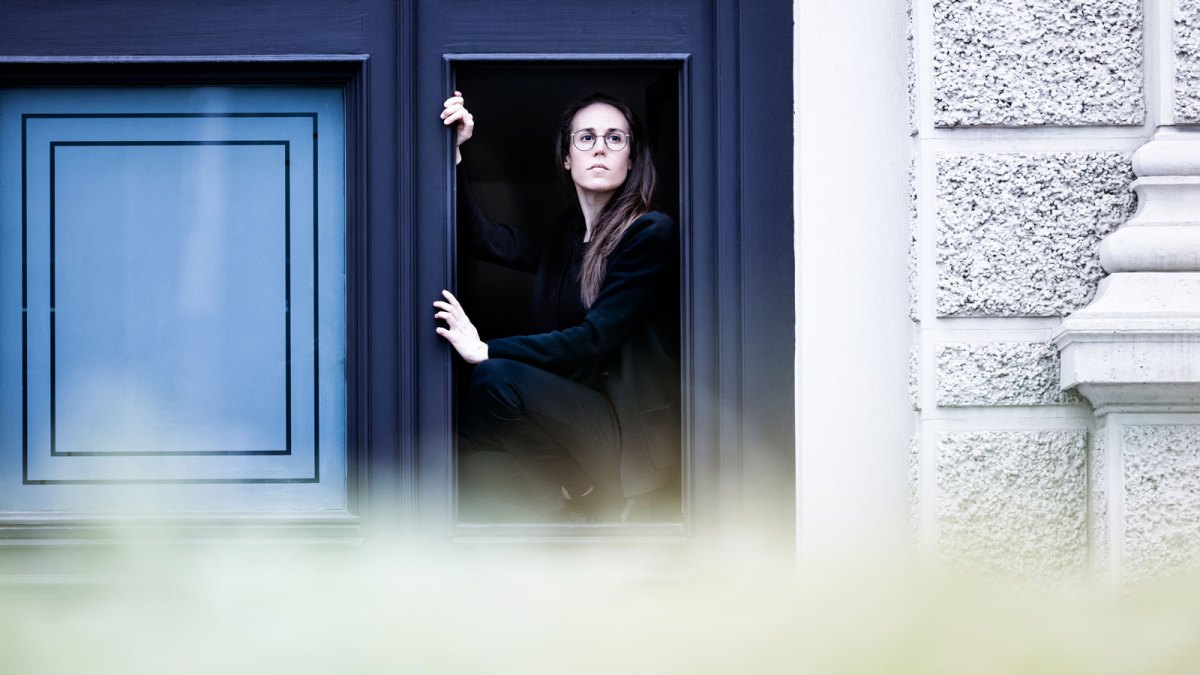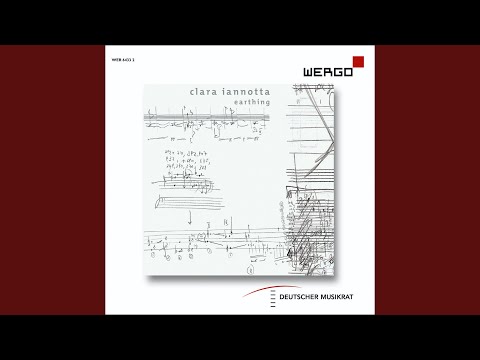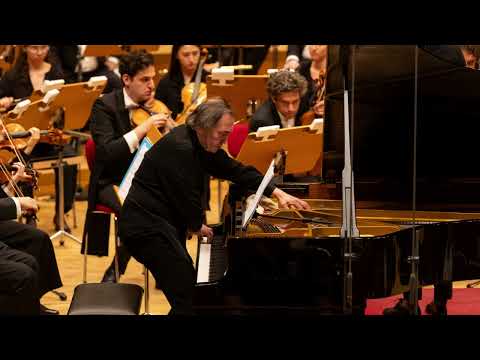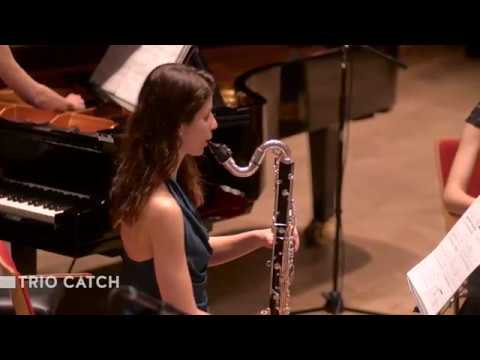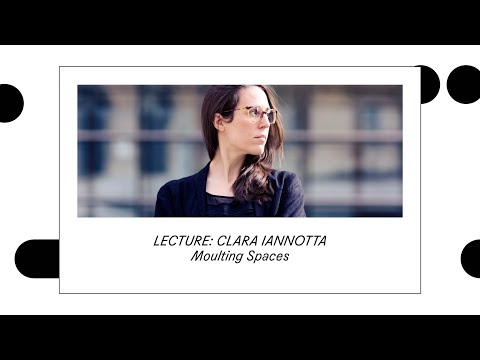I know, I imagine that this unanalyzable feeling changed what there remained for him of existence. As if the death outside of him could only henceforth collide with the death in him. “I am alive. No, you are dead.”
—Maurice Blanchot, “The Instant of My Death”
When a poet puts off an old style… he or she perpetrates an act of violence, so to speak, on the self. It is not too much to say that the old body must be dematerialized if the poet is to assume a new one.
—Helen Vendler, The Breaking of Style
I.
Few composers—perhaps with the exception of Rebecca Saunders, though even Saunders boasts more variation than she does—admit so proper a cathexis as Clara Iannotta. Since 2013, the Italian composer has pulled every one of her titles (without exception; true obsession) from a modest volume of collected poetry by Dorothy Molloy. The single, enigmatic lines—“dead wasps in the jam-jar”; “The people here go mad. They blame the wind.”; “a stir among the stars, a making way”—rarely constitute titles of the poems themselves. Instead, Iannotta tugs at images, spare moments from across Molloy’s eerily quotidian and plainspoken output, recasting them into shadowy worlds of their own. There seems to be no systemic pattern to the choices beyond a contractual obligation that they begin life in Molloy. That degree of singular fixation was what first caught my attention.
Not that the music didn’t; Iannotta is the architect of a breathtaking and insular world, as cavernous as it is painstakingly hermetic. Caves are an apt metaphor for the twin sensations of spaciousness and airlessness that hem her soundworld in, and it is by similarly slow gradations of acclimation that the body grows accustomed to her sunk darkness. That said, she is no stranger to play: toys and music boxes show up with equal measure, often as a kind of amnesiac nostalgia. But they remain encased in rust, creaking and swaying with a haunted, uncanny animation. Far from counterweighting the oppressive dark, these seemingly innocuous objects only further betray the full extent to which her calcifying forms seep cold into everything they meet. (Though what that description fails to capture is the sheer gorgeousness of the temperature drop.)
Iannotta’s world needs no metaphors to be arresting. And so the longer it goes on, the more the Molloy phenomenon entrances me. Never do the poems appear in full in her program notes, nor does she stoop to using the imagistic material as sonic inspiration outright (no jangly collars or sticky footsteps audible in “paw-marks in wet cement,” for example). No, something else is drawing her to these odd lines, a kind of sensual undertow that only she knows how to read.
So I bought the book. And while it’s true, there’s no clear metric or lineation pattern to her choices (nor even a fixed source; Molloy wrote several discrete volumes, which Iannotta draws across indiscriminately), there is an undeniable sense of Clara-ness in certain Molloy lines. So much so that, on first read, one stumbles on turns of phrase that aren’t Iannotta titles but really feel as though they are or ought to be. That kind of phantom limb phenomenon suggests there’s still something particular at play, something more than a random affection for the image.
In comparing various texts, however, certain formal and registral similarities begin to crop up. Iannotta’s titular moments tend to nest themselves in places—or rather, non-places—of rupture, sites of semantic revelation that irreparably alter the poem’s interpretive course. Take Molloy’s “Passage,” whose last four lines became an Iannotta title in 2020:
The teased-up earth
settles.
Nettles sting
in the ducts.
We buried you
today.
Firmed you
in.
The grass seed is
down.
The water
poured.
There is a stir
among the stars:
a cosmic shift;
a making way.
The weight and gravity shift drastically between those third and fourth stanzas. The final two couplets mark an irreparable schism in the poem, a catasterism whose sudden appearance redraws the terms of experience for the entire text before it (and, finally, reveals the full significance of the title). It is not a twist (in the horror-movie sense) so much as a dilation: What we understood to be the borders of this world are now reframed, revealing it as otherwise than we had seen it. The poem takes leave at once of its locality, hurtling towards the stars without ever losing sight of the grave it had so carefully inscribed. The double motion—in which both past and future rebalance along new lines of flight—is deeply characteristic of Molloy’s working method, where trauma and violence carve themselves obliquely in the passing glimpses of mundanity.
These nexuses, these sites of irruption at which the poem becomes other than what it was, are where Iannotta is drawn. Her music seeks out forms of echo, intensity, space, and rate to achieve in sound the effects of residue, perceptive scale, and revelation that take hold in those poetic shifts. She does not want us to feel the jolt itself—the zoom-out from the graveside garden to eternity—but rather to sense, in a pre-linguistic stratum, the burnished imprint of memory that presses on the retina after such a geologic shift has taken place: eternity stitched through with a soft memory of the now-vanished grave.
What rerouting Iannotta back through Molloy reveals about this music is first and foremost its relationship to time. The when of her music is not revelation itself (catastrophic or otherwise) but its aftermath. Situated just beyond the threshold of rupture (the rupture, we might say, is in the title; the music follows), it hovers, unmoored from a past it can but dimly recall and which is forever in recess. It is not too much to say this is a music of loss, if in the same gesture we permit that what has been lost will forever remain outside the purview of the work. It is only the empty indentations left by what is now irrecoverable to which we listeners attend.
One of the last works Iannotta wrote before encountering Molloy was called “D’Après”—after. Her music has always begun in the aftermath, the before being not ours—or perhaps it is entirely, individually ours—to know.
II. (Paris)
This past weekend, Iannotta assumed in full her role as Artistic Director of Music for the Festival d’Automne in Paris. She replaces Joséphine Markovits, the legendary curator who, on her deathbed in April, handpicked the Italian as her heir. It is a remarkable endowment of trust: Markovits began her career in 1972, working in the press office for the festival’s inaugural season, and by 1976 was at the helm. With her appointment, Iannotta becomes only the second music curator in the festival’s 52-year history. The legacy she’s inheriting is vast, a fact she knows well—not least because she was a part of it.
“Joséphine was a visionary,” Iannotta tells me. We’ve already had tea with pastries from the bakery next door and have made our way into the sitting room of the alabaster apartment she calls home in Berlin’s Neukölln neighborhood. She’s perched now, feline and focused, in a square patch of light beneath the window. For a moment I make to sit by her on the couch, then think the better of it and shift, facing her, onto the floor. Something about her poise and her control makes one instinctively sit at her feet.
“Her festival,” she continues, “at least when I was studying in Paris, represented the place where music that I had never heard was happening… Back then, France had a scene that stayed the same throughout the year. And then there was the Festival d’Automne, where I heard [Pierluigi] Billone for the first time, where I heard—twice!—‘Prometeo’ by Nono. She was an absolute visionary.”
The 2024 festival will be one of the last in which Markovits had direct involvement, and Iannotta is painfully sensitive to those traces: For her first solo festival, she has to simultaneously navigate—much to her dismay, and against her expresses wishes—a multi-week portrait of her own music. She’s mortified. On first learning that Markovits had nominated her, Iannotta called leadership directly and begged that they cancel the portraits. She was refused: the curation, she was told, was her predecessor’s last wish.
“One of the most inspiring things she taught me as a curator was how to risk. How to follow your instinct when you find someone that has a raw talent, and how to give them the biggest platform no matter what. And then how to nurture that relationship. That was what she did with me.”
While Iannotta was still a student at the Paris Conservatoire, Markovits, a fixture of the Paris scene and well-known for her habit of just being there, showed up at the school’s composer concert. The visit was on the auspices of a friendship with the conductor, but Iannotta’s work made such an impression that Markovits introduced herself. A few weeks later, Iannotta received a call, and with it, a Festival commission for Ensemble intercontemporain. Today, Iannotta minces no words: “My career started because of Joséphine.”
“But she continued to support me for the next 10 years,” Iannotta goes on, “and that was the real beauty of how she worked. As a curator, she built the kinds of relationships that allowed you to fail, that allowed you to risk and create something that didn’t work now but will work two or three pieces from now. I certainly failed with her. I mean, I made pieces that absolutely did not work. Zero. And I still think that they’re beautiful. Actually, they’re some of the most important experiences of my life, because they allowed me to understand what didn’t work, which is so much better.”
[There is a stir]
The appointment of a composer to the job—of this composer in particular—is hardly left-field: Iannotta is no stranger to the curator’s side of that relationship. Accepting the Paris job means she’ll be relinquishing her tenure in Bludenz, where she’s spent a decade transforming a sleepy provincial town in the foothills of the Austrian Alps into a yearly new music hotspot. As the artistic director of the Bludenzer Tage zeitgemäßer Musik (Bludenzer Days of Contemporary Music)—the job, she says, fell like a gift into her lap—she cut her teeth in festival management, earning a reputation as a provocative curator along the way. When I ask her about how she measures curatorial success—famously difficult to gauge—she cites Bludenz:
“I remember, for example, a concert that I programmed—I won’t say the year—in which there were four world premieres. I had two composers who were so consistent throughout the years, and so I knew what I would get because they had a clear aesthetic. And then there was one who was less consistent, so I thought, OK, we’ll see; and then I had one I knew would be a wild card.
“What happened in that concert?”—she tells stories with a pub-drunk’s enthusiasm—“They became four wild cards. They all did things that they’ve never done and not one of them worked, none of them, absolutely none of them. And so, as a composer, listening to that concert, it was horrible, it was really a bad concert. But then I put my curator hat on and I thought, ‘I am so honored that they trust this festival enough to risk and do something that they’ve never done before. And they did it in my festival!’ And I knew that it would be one of their best experiences, because the piece afterwards will work.”
[among the stars;]
She takes a deep breath and sums: “If you program in a safe way, then you don’t allow people to fail.”
That ethos has paid off in dividends: for every wheels-off wildcard night, Iannotta’s Bludenz earned itself an equally runaway success. Under her watch, Bludenz became a kind of scrappy Darmstadt for the 21st century where rampant compositional freedom and artistic permission bred an astonishing inventory of epoch-making works.
“One of my proudest moments,” she beams, “was when I commissioned [Steve Takasugi’s] ‘Sideshow.’ That was insane. (And you cannot imagine afterwards how many big ensembles would write to me and say, ‘Look, we have this really cool piece by Steve Takasugi,’ and I’m like, ‘Well, yeah, I commissioned it.’) Or ‘Untitled Three Part Construction’ by Michelle Lou. I’ve stopped doing this since, but I chose the musicians and the instrumentation for her, and she came back and said, ‘Oh my God, Clara, I hate this instrumentation.’ Even just a few days before the concert, she told me: ‘I don’t know, Clara, if you’ll like this piece, it’s really weird.’ And I said, ‘look’—and this is something I say to all composers, I said—‘Look: we will celebrate the piece whether it works or not.’ And then it was just like… pfffff, mind-blowing.”
“What I mean is that it will happen that we fail. But that’s how we learn. That needs to be allowed. There has to be space.”
We return again to Paris, to the nuts and bolts of what lies before her. Even as she outlines concrete details of her plan—classic pieces she’d quite like to revive (“I’ve never seen the ‘Lecture on Nothing’ by John Cage done well”; “I’d love to hear [Éliane] Radigue’s ‘Trilogie de la Mort’ in some crazy space”) or ways of shaking up the Festival model—it’s as if she still can’t quite believe the job is hers.
“The first thing I thought when they gave me this job—which, by the way, fell out of the sky, it’s ridiculous that I have this job—but the first thing I thought was: Now that I’m in her position—which is absolutely insane, I mean, I keep saying that Festival d’Automne is the dream I didn’t have—I want to give to so many others the same opportunity she gave to me. I want to go to concerts of students, in Paris but not only in Paris, and try to give the same reward.”
But that requires time and, more specifically, locality. And Iannotta—an Italian living in Berlin and teaching at the University of Music and Performing Arts in Vienna—is hardly the Parisian that Markovits once was. So she’s making changes.
“In order to really build a community, you have to be there,” Ianotta says. “And I do want to be there, because Paris is such a vibrant city. Something is happening there every single day, and it’s one of these places where you can choose which concert to attend because there are four different ones, you know? And so I really have to be present, which is why I’m getting a new apartment in Paris: I plan to spend 50 percent of my time there. Which means I’ll be traveling even more—”
She glances longingly at the ceiling, where her partner—the composer Chris Swithinbank—and toy poodle Pan are hiding out in the office. (For whom she’s theoretically pining is hard to tell; she’s as attached to the dog as him.)
“—than I usually do, but I think it’s extremely important. Trust happens when people see you at shows, when people talk to you. I was lucky enough to spend the few months before Joséphine died talking with her about the 2025 edition, and the first thing that she told me was: bring people that have never come before. And that takes trust, I have to build that.”
Here, Iannotta becomes tender and, for the first time in nearly two hours, appears small, nervous even, before the task ahead.
“Festival d’Automne was something I never dared to dream. And so the fact that I’m a part of it, of an institution that once made my dream come true as a composer… I’m going to work my ass off to create something that I can be proud of and I can make the other people proud of. Because I know that our music can appeal to everybody. I know that there is something for everybody, OK? But I’m not naive, I know also that you have to… I don’t want to say educate your audience, but it’s a slow process. Even for me! I mean, the first time I heard new music, I was like, Oh my God, no. But then you’re like, I can’t stop thinking about it. The same way you educate yourself about coffee and taste, you educate the way you listen.”
[a cosmic shift;]
Or, in her case, the way you see. Since learning about the appointment, Iannotta has made a concerted attempt to bring herself up to speed in contemporary theater, opera, and dance—all arenas she admits to overlooking in her compositional search for sonic integrity. (To date, she’s refused to even touch the voice, though rumor has it that’s soon changing.) While her main responsibility in Paris is music—Francesca Corona handles theater—the festival boasts a blistering track record of scouting out once-in-a-generation operas (“Einstein on the Beach” received its second performance there, as did Liza Lim’s “The Navigator”; Robert Ashley’s “Perfect Lives” enjoyed a Paris show three years before its television premiere). Iannotta knows she has to preserve that mantle.
“I realized I have to start engaging and learning about this art world that somehow I put… not aside, but I was interested at the time in other things. I spent this full year just going to operas, to theater, to dance, and my mind blew up! It’s incredible how much I was missing out, but also how much my mind is changing right now. I mean, I’ve always known that you don’t experience sound only through your ears. But now, for example, I saw text and I saw staging, I’m like a kid in this new, beautiful, other world full of color.”
The latest from VAN, delivered straight to your inbox
Which brings her back—inevitably—to “Sancta.” At 20-minute increments since walking in the door (again, Clara is a true obsessive), Florentina Holzinger’s new music-dance-theater creation has wormed its way into our discussion. “Sancta” takes as its impetus Paul Hindemith’s little-played “Sancta Susanna,” an opera about a nun’s pornographic fantasies, and then runs riot with the naked nun idea (in one especially moving sequence, a nude woman hangs upside down in an immense cathedral bell, swinging to and fro like a human clapper). Iannotta saw it in Vienna, and afterward, she says, spent two hours circling the block, too stunned and overwhelmed to go inside.
“It’s been a long time since I’ve been that shaken. The piece had such an impact on me, so much so that in the piece I’m writing now, I’m doing things I’ve never done, exactly because I want to try something. I want to try something I thought I didn’t need—and maybe I still don’t need, but I want to try it anyway.”
[a making way.]
“When I think about what I want in my life—as a curator, as a composer, as a person—I want there to be a before and after.”
III.
(A theory of revelation)
Can we speak of revelation as a physical phenomenon? By which I mean to ask: What becomes of the body newly torn from its ongoingness? Can it be said to be the same body? Or does revelation’s laying bare—as its etymology (from the Latin revelare) indicates—demand dehiscence, a cloven second body capable of turning to assess the dumb and naked first? In other words: who is laid bare and who does the laying bare?
Blanchot’s formula from the epigraph above—“this unanalyzable feeling [that] changed what there remained for him of existence”—is, without saying so, a brief theory of revelation. It has to do with the future, and with death, and a death which alters in the instant the trajectory of the body at hand. That it comes in Blanchot’s fictionalized testimonial of his own close brush with death is no accident: revelation always encloses an end. Something dies, while something else goes on.
“I am alive. No, you are dead.”
Revelation: the impossible orientation between that “I” and “you.”
This is Vendler’s point when she insists that artistic style is better understood as a material body. Doing so permits its termination, which is crucial to approaching how individual artists adapt and transform their work in relation to the changing of their epoch. When one is forced, by circumstance or fact, to change one’s style—even, as she demonstrates, from one work to another—a mortification occurs. Following Vender just a little further on, we might go so far as to say that any revelation, but especially one followed by serious reconstitution (“The Breaking of Style”), is both a form of death with life inside and a form of life with death inside. Either way, one cannot continue to be as one was.
Iannotta has said this much before. Her 2021 Darmstadt lecture was about spiders, about the molting of their bodies and about the empty carcass and about how violence forever leaves a trace. She used a phrase that day that I’ve never quite been able to shake. It was about insects then, but today reads as a kind of summation of her whole musical project: “We are confronted by the physical trace of the past within the movement of the present, a vision of the self split across time.”
The spider, heaving wet and fragile from ecdysis, gazes upon its own carcass with mingled horror and dawning recognition: “I” is now a “you.”
I want there to be a before and after means allow yourself to die here, just a little. ¶
Subscribers keep VAN running!
VAN is proud to be an independent classical music magazine thanks to our subscribers. For just over 10 cents a day, you can enjoy unlimited access to over 875 articles in our archives—and get new ones delivered straight to your inbox each week.
Not ready to commit to a full year?
You can test-drive VAN for one month for the price of a coffee.

